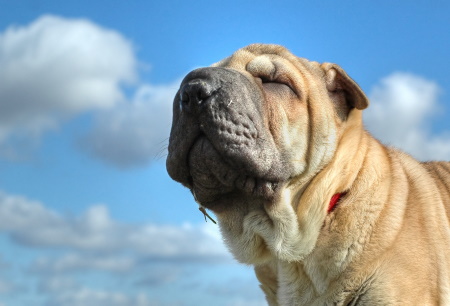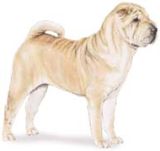Chinese Shar-pei Dog
Affectionate Yet Independent!
The Chinese Shar-pei dog is an ancient breed that originated in China around the time of the Han Dynasty about 200 B.C., and although its lineage is not well-defined, many believe the mastiff and chow chow breeds were involved in its development.

Early history reveals that the Shar-pei's purpose was as a working and hunting breed.
Some time later they were introduced as fierce contenders
in the dog-fighting arena. It is said, the dog's wrinkly skin folds helped him survive fights by acting as a protective barrier.
Thankfully this "sport" faded away when the country became a communist nation, but, sadly, dogs were also pretty much eliminated during this transition.
However, although this caused a steep decline in Chinese Shar-pei dogs, fanciers
came to the rescue, among them most notably a gentleman by the name of
Matgo Law from Hong Kong who was instrumental in getting a few of the
breed into the hands of American and Canadian breeders.
This time around, breeders worked toward developing the breed's temperament for family companionship.
You will not easily forget this unusual dog breed once you catch sight
of his abundantly wrinkled appearance.
In case you might be wondering about what the "Shar-pei" name means, a rough translation is: draping sand paper like skin - a reference to its unique short and rough coat.
Another extremely
rare feature is a blue-black tongue - a characteristic shared only with
the chow chow breed.
Nowadays, having left his former lifestyle far behind him, the Chinese Shar-pei
dog (CSP) is a popular family companion and a frequent participant in the show
dog arena.
In 1992 the Chinese Shar-Pei dog was recognized as a breed by the AKC and placed in the non-sporting dog group.
Before that time the breed had almost become extinct until in 1974, a small group of people established the Chinese Shar-Pei Club of America (CSPCA) becoming a main source of reliable information about the breed.
Even so, it was still one of the world's rarest breeds. The United States reportedly only had around 40 CSP's in 1975.
Characteristics of the Chinese Shar-Pei Dog

At one point, not too long ago, the Chinese Shar-pei dogs were very rare and extremely sought after which resulted in a rash of irresponsible breeding.
This, combined with its not too distant history as an aggressive fighting dog, means that there can be a variety of
temperament and traits, both favorable and unfavorable, seen in the breed. It is another case where a reputable breeder
should be sought by those interested in the breed.
While the Chinese Shar-pei dog has in general been proven to have many positive qualities, such as loyalty, courage and affection, he
can be quite independent. One thing to keep in mind, is that they need an experienced owner who can confidently train them
with consistency, but never harshly.
They respond very well to their master's praise and rewards, yet are quick to spot any weakness in him.
Early socialization is recommended to get this unique breed, that is
sure to attract attention, used to people contact plus a variety of
experiences, places and situations, as well as meeting other canines.
When it comes to house training, the Shar-pei is a quick learner, if this is started early - say in the first three
months - before they start testing you!
Appearance and Care
Weight: 35 to 55 pounds
Height: Ranges between 18 to 20 inches
The acceptable coat colors of the AKC standard are limited to solid and
sable. It is permissible for the solid colors to have darker shading
of the dominant color on the ears, down the back and throughout the
coat.
The shading must be variations of the same body color and may include
darker hairs throughout the coat.
Disallowed colors include albinos, brindle, parti-colored, or patterned.
The standard coat is one that is harsh and completely straight and stand-offish on the main body area, while being a bit smoother and flatter on the legs.
Alternatively, it may
have a very short coat - referred to as a 'horse coat', or one not
longer than 1" -
known as a brush coat.
The brush coat sheds a light amount year round, while the horse coat has periods of heavy molting. Both coats
can benefit from the use of a FURminator to remove dead hair and keep the coat healthy.
Maintenance includes brushing, attention to cleanliness of the wrinkled areas, nail grinding or clipping, ear cleaning, and bathing about once a month or as needed.
Health of the Shar-pei
The Chinese Shar-pei dog may be affected by the following conditions during its lifespan of 8-12 years:
- Malformations of the eyelids, a condition which needs to be surgically corrected to prevent ulcerations on the eyes.
- Hereditary skin problems.
- Demodectic mange.
- Hip dysplasia.
- Food allergies - particularly wheat and soy
- Most importantly, Chinese Shar-pei dogs are at risk for the hereditary disease of Familial Shar-Pei Fever which can lead to renal amyloidosis - the abnormal accumulation of amyoloid protein around the body. The propensity for this disease is carried in the genes to a greater or lesser degree in all lines of the breed.
Learn as much as you can about the parents health before you invest in a puppy. And, have a reliable vet at the ready to evaluate the puppy's health soon after you acquire one.
Active Level
Most definitely, this breed needs a good walk each day. Keep an eye on the temperature though for this is one of the breeds
that doesn't tolerate hot weather very well.
In addition, a chance to romp and play outside in the yard, for days when walks are not possible.
Ideal Living Space
An uncrowded house and yard where the Shar-pei dog has some space, is the ideal situation.
Outside areas should have shady spots
plus the availability of water at all times out of consideration for the Shar-pei dog's sensitivity to higher temperatures.
The Shar-pei With Children?
This breed is best suited to families with young adult children who are more mature in their respect for pets and have had previous opportunities to interact with them.
As with any breed, it
is always the recommended policy to have an adult supervise interactions between children and pets.
Companion for Seniors?
The Chinese Shar-pei dog would not be the most ideal companion for seniors unless they have considerable experience handling dogs as a "take charge" owner.
CSPs are from the non-sporting dog group which is very diversified and not easily categorized. While being very loyal and protective Shar-Peis can vary in characteristics and should be acquired from a professional breeder who can provide full background information.
Exercise needs also need to be provided by someone in the family on a daily basis.
Note: Seniors interested in the Shar-Pei might want to check out the sporting dog breeds before deciding. The sporting breeds include spaniels and retrievers among many others.
Top image courtesy pxhere.com
Shar-pei Books
 |
 |
- Home ›
- AKC Breeds ›
- Non-Sporting Breeds ›
- Chinese Shar-Pei

